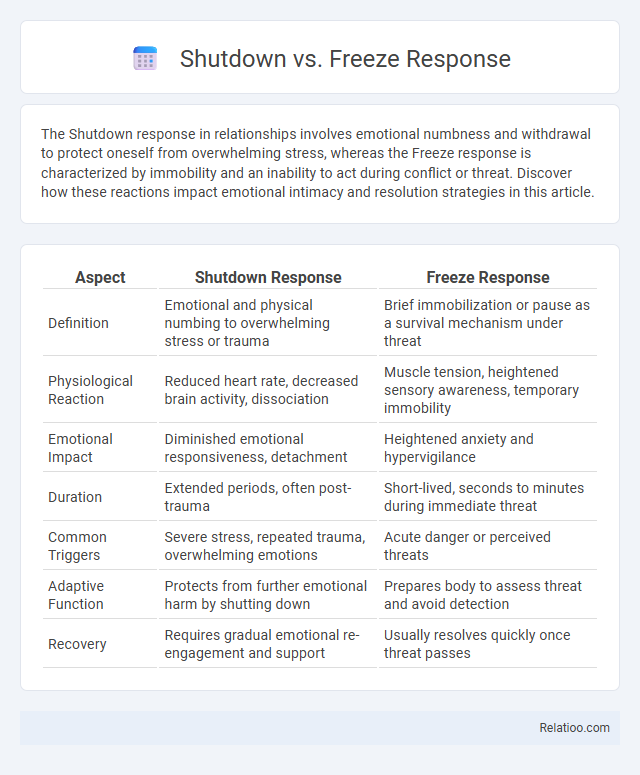The Shutdown response in relationships involves emotional numbness and withdrawal to protect oneself from overwhelming stress, whereas the Freeze response is characterized by immobility and an inability to act during conflict or threat. Discover how these reactions impact emotional intimacy and resolution strategies in this article.
Table of Comparison
| Aspect | Shutdown Response | Freeze Response |
|---|---|---|
| Definition | Emotional and physical numbing to overwhelming stress or trauma | Brief immobilization or pause as a survival mechanism under threat |
| Physiological Reaction | Reduced heart rate, decreased brain activity, dissociation | Muscle tension, heightened sensory awareness, temporary immobility |
| Emotional Impact | Diminished emotional responsiveness, detachment | Heightened anxiety and hypervigilance |
| Duration | Extended periods, often post-trauma | Short-lived, seconds to minutes during immediate threat |
| Common Triggers | Severe stress, repeated trauma, overwhelming emotions | Acute danger or perceived threats |
| Adaptive Function | Protects from further emotional harm by shutting down | Prepares body to assess threat and avoid detection |
| Recovery | Requires gradual emotional re-engagement and support | Usually resolves quickly once threat passes |
Understanding Shutdown and Freeze Responses
Shutdown and freeze responses are involuntary survival mechanisms triggered by extreme stress or trauma, where the body either becomes immobile or temporarily unresponsive. Shutdown response involves a complete decrease in physical and mental activity, leading to a sense of numbness or dissociation, while freeze response is characterized by an alert but motionless state as the body assesses danger. Understanding these responses helps differentiate between passive collapse and heightened vigilance, crucial for trauma-informed care and mental health support.
Definition of Shutdown Response
The shutdown response is a physiological and psychological reaction where the body minimizes energy use by reducing movement, speech, and responsiveness to external stimuli, often occurring during extreme stress or trauma. It differs from the freeze response, which involves brief immobility paired with heightened alertness, and from general shutdown states that may include prolonged disengagement without immediate stress triggers. Understanding the shutdown response is crucial in trauma therapy, as it reflects an adaptive survival mechanism in response to overwhelming threat or danger.
Definition of Freeze Response
The freeze response is a survival mechanism where your body temporarily becomes immobile, often characterized by a state of heightened alertness without physical movement, enabling you to assess threats more effectively. Unlike shutdown, which involves a complete dissociation or loss of responsiveness, the freeze response keeps the nervous system on high alert while suppressing voluntary actions. Understanding the freeze response helps differentiate it from shutdown and better recognize how your body instinctively manages extreme stress or danger.
Neurobiology Behind Shutdown vs Freeze
The neurobiology behind shutdown and freeze responses involves distinct brain circuits and neurotransmitter systems. Freeze response is primarily mediated by the amygdala and periaqueductal gray, triggering heightened alertness and immobility as a survival strategy. Shutdown engages the parasympathetic nervous system more profoundly, leading to a state of hypoarousal and decreased metabolic activity, which can feel like dissociation or numbness to Your body during extreme stress or trauma.
Key Differences Between Shutdown and Freeze
The shutdown response involves a complete disengagement and immobilization as a protective reaction to overwhelming stress, characterized by a decrease in physiological and emotional activity. In contrast, the freeze response is a momentary pause or stillness that allows an individual to assess threats before deciding on fight or flight, marked by heightened sensory awareness despite physical immobility. Key differences between shutdown and freeze include the level of consciousness and neural activation: shutdown leads to lowered awareness and energy depletion, whereas freeze maintains alertness with readiness for rapid action.
Common Triggers for Shutdown and Freeze
Common triggers for shutdown and freeze responses often include intense stress, overwhelming sensory input, and perceived threats that leave the brain unable to process or react effectively. Shutdown is characterized by a complete disconnection from external stimuli and a drop in responsiveness, typically triggered by extreme exhaustion or trauma. Freeze responses usually involve temporary immobility and heightened alertness caused by fear or danger, signaling your body's attempt to protect itself in moments of threat.
Behavioral Signs of Shutdown vs Freeze
Behavioral signs of shutdown include lethargy, minimal movement, and reduced responsiveness as the body conserves energy in overwhelming situations. Freeze response manifests through momentary immobility, wide eyes, and heightened alertness, preparing your body to either flee or fight. Recognizing these distinct reactions helps you better understand how individuals cope with extreme stress and trauma.
Psychological Impact of Each Response
Shutdown, freeze, and shutdown responses are distinct psychological reactions to extreme stress or trauma, each impacting mental health differently. The freeze response causes temporary paralysis and heightened vigilance, often leading to feelings of helplessness and confusion, while the shutdown response involves emotional numbing and dissociation, resulting in a sense of disconnection from oneself and the environment. Understanding how Your brain and body respond during these states helps tailor therapeutic approaches, promoting recovery and resilience after traumatic experiences.
Managing Shutdown and Freeze in Daily Life
Managing shutdown and freeze responses in daily life requires recognizing bodily cues that signal stress overload. You can implement grounding techniques such as deep breathing, sensory engagement, or gentle movement to help interrupt these automatic responses and regain control. Establishing a consistent routine with self-care practices enhances resilience and reduces the frequency of shutdown or freeze episodes.
Supporting Others Through Shutdown and Freeze
Supporting others through shutdown and freeze responses requires recognizing these as involuntary reactions to overwhelming stress or trauma, often marked by immobility, emotional numbness, or dissociation. Techniques such as offering a calm, safe environment, using grounding exercises, and maintaining patient, non-verbal communication can help individuals gradually regain control and feel secure. Understanding the distinct physiological and psychological aspects of shutdown versus freeze responses enhances empathy and effectiveness in providing compassionate support.

Infographic: Shutdown vs Freeze Response
 relatioo.com
relatioo.com